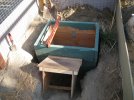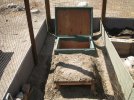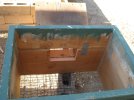Hello all! This is my first post. I have learned a lot from the forums. I adopted my adult Russian tortoise this spring and I live in Southwest USA, very hot desert environment. He lives in an outdoor enclosure in my backyard. 😊
In June, when the weather got above 100 degrees he went into hiding one night and I have not seen him for over a month! It's now end of July. I don't believe he escaped as the enclosure is built to prevent escape, and my yard is sealed off anyway and I have not seen him gotten out. I have tried digging for him under his hide where I last saw him, but can't find him after digging 6-8 inches. He may also possibly have dug himself under a plant shrub he likes to sleep under, however it was not possible for me to dig under the plant roots. I am hoping he is down there. I still make sure there is water everyday, and there are many plants in the enclosure for him to eat if he does decide to wander out, though I have not seen him out yet despite checking early mornings and later evenings when it is cool. It has rained a couple times this summer and I thought for sure I'd see him the following mornings or evenings, but no luck yet.
I have read all about summer estivation however cannot find exactly just how long they can stay under. I've read on other threads that they might stay buried from June to October for the entire summer! 😓 What has been your experience for those who have outdoor-living Russian tortoises in hot & arid climates? How deep can they dig? All I can do now is wait until he hopefully comes out in the Fall, but some reassurance would be very helpful! Thanks so much!!! 🙏
In June, when the weather got above 100 degrees he went into hiding one night and I have not seen him for over a month! It's now end of July. I don't believe he escaped as the enclosure is built to prevent escape, and my yard is sealed off anyway and I have not seen him gotten out. I have tried digging for him under his hide where I last saw him, but can't find him after digging 6-8 inches. He may also possibly have dug himself under a plant shrub he likes to sleep under, however it was not possible for me to dig under the plant roots. I am hoping he is down there. I still make sure there is water everyday, and there are many plants in the enclosure for him to eat if he does decide to wander out, though I have not seen him out yet despite checking early mornings and later evenings when it is cool. It has rained a couple times this summer and I thought for sure I'd see him the following mornings or evenings, but no luck yet.
I have read all about summer estivation however cannot find exactly just how long they can stay under. I've read on other threads that they might stay buried from June to October for the entire summer! 😓 What has been your experience for those who have outdoor-living Russian tortoises in hot & arid climates? How deep can they dig? All I can do now is wait until he hopefully comes out in the Fall, but some reassurance would be very helpful! Thanks so much!!! 🙏







